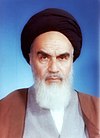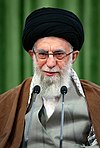ব্যবহারকারী:Tuhin/খেলাঘর ২
The Supreme Leader directly chooses the ministers of Defense, Interior, Intelligence and Foreign Affairs, as well as certain other ministers, such as the Education, Culture and Science Minister.[১] Iran's regional policy is directly controlled by the office of the Supreme Leader with the Ministry of Foreign Affairs' task limited to protocol and ceremonial occasions. All of Iran's ambassadors to Arab countries, for example, are chosen by the Quds Force, which directly reports to the Supreme Leader.[২]
The office was established by the Constitution of Iran in 1979, pursuant to the concept of the Guardianship of the Islamic Jurist.[৩] According to the Constitution, the powers of government in the Islamic Republic of Iran are vested in the legislature, the judiciary, and the executive powers, functioning under the supervision of the Supreme Leader.[৪] The style "Supreme Leader" (ফার্সি: رهبر معظم, প্রতিবর্ণীকৃত: rahbar-e mo'azzam) is commonly used as a sign of respect – although the Constitution simply designates them as "Leader" (رهبر, rahbar).
The Supreme Leader ranks above the President of Iran and personally appoints the heads of the military, the government, and the judiciary.[৫] Originally the constitution required the Supreme Leader to be Marja'-e taqlid, the highest-ranking cleric in the religious laws of Usuli Twelver Shia Islam. In 1989, however, the constitution was amended and simply asked for Islamic "scholarship", thus the Supreme Leader could be a lower-ranking cleric.[৬][৭]
In its history, the Islamic Republic of Iran only has had two Supreme Leaders: Ruhollah Khomeini, who held the position from 1979 until his death in 1989 and Ali Khamenei, who has held the position since Khomeini's death.
In theory, the Supreme Leader is elected by the Assembly of Experts. However, all candidates for membership at the Assembly of Experts (including the President and the Majlis (parliament)) must have their candidacy approved by the Guardian Council, whose members in turn, are half appointed unilaterally by the Supreme Leader and half subject to confirmation by the Majlis after being appointed by the head of the Iranian judiciary, who is himself appointed by the Supreme Leader.[৮] Thereby, the Assembly has never questioned the Supreme Leader.[৯] There have been cases where incumbent Ali Khamenei publicly criticized members of the Assembly, resulting in their arrest and subsequent removal. There also have been cases where the Guardian Council repealed its ban on particular people after being directed to do so by Khamenei.[১০] The Supreme Leader is legally considered "inviolable", with Iranians being routinely punished for questioning or insulting him.[১১][১২][১৩][১৪]
সর্বোচ্চ নেতার তালিকা[সম্পাদনা]
| ক্রম | সর্বোচ্চ শাসন | প্রতিকৃতি | নাম বাংলা · ফার্সি · স্বাক্ষর |
জীবনকাল | জন্মস্থান | মন্তব্য |
|---|---|---|---|---|---|---|
| ১ | ৩ ডিসেম্বর ১৯৭৯ – ৩ জুন ১৯৮৯ (৯ বছর, ১৮২ দিন) |

|
মহান আয়াতুল্লাহ ইমাম সৈয়দ রুহুল্লাহ খোমেনি سیدروحالله خمینی 
|
১৭ মে ১৯০০ – ৩ জুন ১৯৮৯ (বয়স ৮৯)[১৫] | খোমেইন, মার্কাজি প্রদেশ | ১৯৭৯ সালের ইরানি বিপ্লবের নেতা,[১৬] এবং ইসলামী প্রজাতন্ত্র ইরানের প্রতিষ্ঠাতা। [১৭] |
| ২ | ৪ জুন ১৯৮৯ – বর্তমান (৩৪ বছর, ৩১৯ দিন) |

|
মহান আয়াতুল্লাহ ইমাম সৈয়দ আলী খামেনেয়ী سیدعلی خامنهای |
১৬ জুলাই ১৯৩৯[১৮] | মাশহাদ, রাজাভি খোরসন প্রদেশ | পূর্বে ১৯৮১ থেকে খোমেনির মৃত্যু পর্যন্ত ইরানের রাষ্ট্রপতি হিসাবে দায়িত্ব পালন করেছিলেন।[১৯] |
- ↑ mshabani (২৩ অক্টোবর ২০১৭)। "Did Khamenei block Rouhani's science minister?"। ২৪ অক্টোবর ২০১৭ তারিখে মূল থেকে আর্কাইভ করা।
- ↑ উদ্ধৃতি ত্রুটি:
<ref>ট্যাগ বৈধ নয়;autoনামের সূত্রটির জন্য কোন লেখা প্রদান করা হয়নি - ↑ Article 5, Iranian Constitution
- ↑ Constitution of Iran ওয়েব্যাক মেশিনে আর্কাইভকৃত ২০১৮-০৮-২১ তারিখে Unofficial English translation hosted at University of Bern, Switzerland (with good summaries)
- ↑ "Who's in Charge?" by Ervand Abrahamian London Review of Books, 6 November 2008
- ↑ Moin, Baqer, Khomeini, (2001), p.293
- ↑ "Article 109 [Leadership Qualifications]
(1) Following are the essential qualifications and conditions for the Leader:
a. Scholarship, as required for performing the functions of the religious leader in different fields. - ↑ Reuters (১৪ ডিসেম্বর ২০১৫)। "Rafsanjani breaks taboo over selection of Iran's next supreme leader"। ১৮ ডিসেম্বর ২০১৬ তারিখে মূল থেকে আর্কাইভ করা। সংগ্রহের তারিখ ১ জুলাই ২০১৬।
- ↑ "Everything you need to know about Iran's Assembly of Experts election"। ৩০ নভেম্বর ২০০১। ২২ এপ্রিল ২০১৬ তারিখে মূল থেকে আর্কাইভ করা। সংগ্রহের তারিখ ১ জুলাই ২০১৬।
- ↑ Staff and agencies (২৪ মে ২০০৫)। "Iran reverses ban on reformist candidates"। ২১ ডিসেম্বর ২০১৬ তারিখে মূল থেকে আর্কাইভ করা। সংগ্রহের তারিখ ১ জুলাই ২০১৬।
- ↑ "Iran arrests 11 over SMS Khomeini insults"। GlobalPost। ১৪ মার্চ ২০১৬ তারিখে মূল থেকে আর্কাইভ করা।
- ↑ "Iran arrests 11 over SMS Khomeini insults: report"। The Daily Star। ২২ সেপ্টেম্বর ২০১৭। ৫ ফেব্রুয়ারি ২০১৭ তারিখে মূল থেকে আর্কাইভ করা। সংগ্রহের তারিখ ৪ ফেব্রুয়ারি ২০১৭।
- ↑ "Poet to Serve Two Years in Prison For Criticizing Iran's Supreme Leader"। ডিসেম্বর ৩০, ২০১৭। জানুয়ারি ১২, ২০২০ তারিখে মূল থেকে আর্কাইভ করা। সংগ্রহের তারিখ ডিসেম্বর ৮, ২০১৯।
- ↑ Vahdat, Ahmed (মার্চ ১৯, ২০১৯)। "Iranian dissident ordered to copy out books by Ayatollah Khamenei after branding Supreme Leader a despot"। The Telegraph। মে ১৪, ২০১৯ তারিখে মূল থেকে আর্কাইভ করা। সংগ্রহের তারিখ মে ১৪, ২০১৯ – www.telegraph.co.uk-এর মাধ্যমে।
- ↑ "Imam Khomeini's Biography"। ২১ ফেব্রুয়ারি ২০১৫। ২১ ডিসেম্বর ২০২০ তারিখে মূল থেকে আর্কাইভ করা। সংগ্রহের তারিখ ১৫ ডিসেম্বর ২০২০।
- ↑ Steinzova, Lucie; Greer, Stuart (৮ ফেব্রুয়ারি ২০১৯)। "In Pictures: Iran's 1979 Islamic Revolution"। RFE/RL। ২০ ফেব্রুয়ারি ২০২০ তারিখে মূল থেকে আর্কাইভ করা। সংগ্রহের তারিখ ৪ জানুয়ারি ২০২০।
- ↑ Nettleton, Todd (২ জানুয়ারি ২০২০)। "Ayatollah Khomeini: The greatest Christian missionary in the history of Iran"। Christian Post। ৩ জানুয়ারি ২০২০ তারিখে মূল থেকে আর্কাইভ করা। সংগ্রহের তারিখ ৪ জানুয়ারি ২০২০।
- ↑ "Detailed biography of Ayatollah Khamenei, Leader of Islamic Revolution"। ২৩ সেপ্টেম্বর ২০১৩। ১০ এপ্রিল ২০১৬ তারিখে মূল থেকে আর্কাইভ করা। সংগ্রহের তারিখ ২৭ মে ২০১৭।
- ↑ Vatanka, Alex (২৯ অক্টোবর ২০১৯)। "Iran's IRGC Has Long Kept Khamenei in Power"। Foreign Policy। ১০ ডিসেম্বর ২০১৯ তারিখে মূল থেকে আর্কাইভ করা। সংগ্রহের তারিখ ৪ জানুয়ারি ২০২০।
